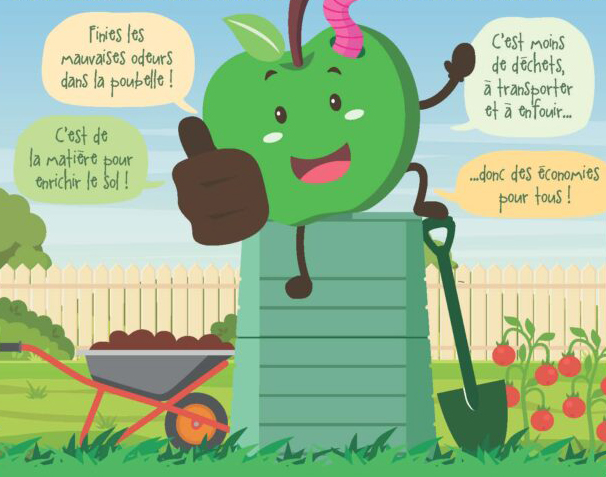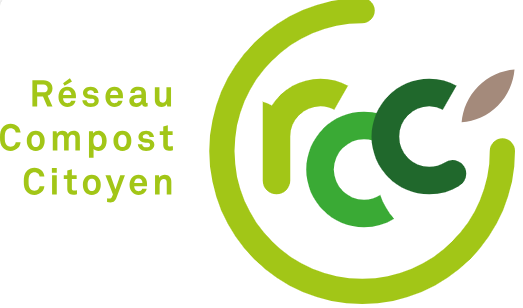The €15 composter
The QRGA CC sells residents a composting kit at the special price of €15. The kit includes a compost bin, an aerator, a bio-bucket, a composting guide and an after-sales service to answer any questions you may have.
Find out more
COMPOST
What is composting?
It's the decomposition of natural, degradable waste (food scraps, peelings, garden waste, etc.) into a natural, very rich fertiliser, similar to topsoil: compost.
Why compost?
Produce a free, natural fertiliser for gardens and crops that also improves the soil's ability to retain water.
Reduce the weight of our household waste bins (1/3) and therefore reduce pollution and the costs associated with transport and treatment.
How does it work?
Under the right conditions, bacteria and fungi present on or in food (micro-organisms), insects (micro-fauna) and small invertebrates (worms) work to break down matter.

By composting, we reproduce the decomposition process that occurs naturally in a forest.
1. Composting in piles
Biodegradable waste left in a heap at the bottom of the garden can eventually be composted. However, this method requires space. The heap is often unsightly, inconvenient to turn over and aerate, and may be visited by your pets and other pests. Composting takes a long time and the end result is compost that has lost some of its nutritional qualities because it is washed away by the rain.
The heap is only suitable for very large volumes of compost.
2. On-site composting
This involves depositing your bio-waste under the mulch in your growing areas.
Advantages: it's simple and highly effective.
Disadvantages: you won't have any compost to hand for repotting or planting trees and shrubs, and there's a risk that your pets will go picnicking there.
3. Individual compost bin
This is a large container in which the decomposition of organic matter is optimised to produce compost quickly. This option is ideal for households with outdoor space. Composting in a bin is suitable for smaller volumes. It keeps the waste out of sight and protected from animals and the vagaries of the weather. A closed composter gives a better quality result but requires more regular monitoring (see compost management advice below).
4. Collective composting
A solution for groups of individuals who do not have their own outdoor space. One or more compost bins can be installed at the bottom of a building or in a park for use by this group. In such a case, the CC QRGA asks that (at least) two members of this group of residents follow our free Site Referent training course. These Site Referrers are the direct contacts for site users. They benefit from the support of the Compost Guides and Master Composters of the CC QRGA in terms of training, leadership, assistance and long-term monitoring. If you have any questions about collective composting, please write to preventiondéchets@cc-qrga.fr or call 05 63 65 77 89.
5. Other solutions
Vermicomposters (composting in small boxes with glasses of soil) and Bokashi (fermentation in a small container) are solutions for small volumes that do not require outdoor space.
For professionals producing large volumes, we talk about in-house composting.
1. Vary your intake
Add a little bit of everything in pieces (including citrus fruits). For every 1 dose of "green, moist, nitrogenous" matter (fruit and vegetables, etc.) add ½ dose of "brown, dry, carbonaceous" matter (shreds, dead leaves).
2. Ventilate
It's important to stir the compost regularly, using a fork, a stirring harpoon or a compost stirrer.
3. Moisten
Proper humidification ensures a good composting process
- Choosing a location and installing your composter
Adapted to your composter, it should not be too far from your house (the kitchen bucket should be emptied regularly). Your composter will appreciate a semi-shaded corner, protected from gusts of wind and very flat. It must be placed on a flat surface. It is preferable to place it on grass to allow the soil's micro-organisms to penetrate. If this isn't possible, don't worry - the micro-organisms on and in your food and the insects in the vicinity will still do the job.
- Filling your composter for the first time
To prevent liquids from stagnating in your composter, start by filling it with small twigs, straw, shredded material, etc.
When your biobucket (kitchen container for your bio-waste) is full, pour it into your composter.
After several contributions, think about digging a small crater in your bio-waste (a small gardening claw can prove useful) and pour the contents of your biowaste container into it. Cover with a little "dry" material (dry leaves, shredded material, etc.). For every dose of "wet" material you bring in (your peelings and food scraps), add half a dose of "dry" material.
For the next addition, start by stirring the contents with an aeration tool (harpoon, brass'compost, gardening claw, etc.) over a distance of around twenty centimetres, then make a crater, pour in the contents of your biobucket and cover with dry matter.
And so on.
Unless you bring in a very large quantity, the 400L composter supplied by the CC QRGA is sufficient for a family of two adults and children. After a few months (around 6), you will notice that the material in your composter has almost halved.
- We compost:
- Leftovers Fish and meat are reserved for experienced cooks.
- Fruit (including citrus) and vegetables,
- Peeled and damaged Cut into pieces, raw or cooked. It is a moist, nitrogenous material.
- Paper towels and tissues
- uncoloured
In small quantities :
- Small brown cardboard boxes (paper towel rolls), egg cartons cut into pieces, in small quantities.
- Crushed eggshells. Do not decompose but add limestone. Can be used as mulch.
- Crushed peanut and walnut shells. In small quantities. Can be used as mulch.
- We don't compost:
- Plastic bags, cutlery, crockery, even if it says "biodegradable" or "compostable".
- Earth, stone, rubble, ashes.
- Pet excrement and litter (even "biodegradable" or "compostable")
- Coloured newspapers, magazines, food packaging and cardboard.
- Glass, metal and plastic are recycled
- Meat, fish (for experienced cooks only)
- What about garden waste? I don't see why not.
- Fresh grass clippings are considered to be nitrogenous matter (wet) and can be added to moisten your compost. Dry grass clippings are a carbonaceous material and add structure to the mixture. Always add it in small quantities and mix well. For large quantities, use dry grass clippings as mulch in the vegetable garden and around trees, or in a lasagne garden.
- Manure (horse, sheep, donkey, etc.) sparingly.
- Hedge trimming, coarse sawdust, wood shavings Diameter <1cm and fragment <10cm. Shred. Use this carbonaceous material to structure and aerate the compost.
- Mix dead leaves gradually with wet matter. Build up a stockpile protected from moisture over the winter.
To recognise mature compost, all you need to do is make a few simple observations:
- A scent of undergrowth emanates from the material
- The compost is brown, almost black in colour
- It is impossible to recognise the materials introduced at the beginning, everything is fine and homogeneous (apart from the small branches you put in to structure your compost).
- There are far fewer worms and insects
Few plants can tolerate pure compost, so mix it with soil.
- 3 to 4 months :
A very coarse material that can be used as a mulch. Spread a few centimetres over cultivated areas and around trees and shrubs, it will limit evaporation and weed regrowth while gradually enriching the soil.
- 6 to 8 months :
Semi-walled compost, fairly coarse, can be spread on the soil as an amendment.
- 10 to 12 months :
Mature compost. Whether sieved or not, it should smell of the forest, be black and crumbly and contain no visible elements of your inputs (except for those that do not decompose or decompose only very slowly, e.g. eggshells, wood, etc.). To plant, sow or repot, mix 50% with garden soil.
Don't delay using your mature compost as it will mineralise and lose its nutritional properties over time.
- How regularly should you brew?
The regularity of stirring depends on the quantity of feed. The more you add, the more regularly you should stir. During the winter, it is not advisable to stir so as not to cool the compost too much. Otherwise, a weekly surface stir (20cm) and a monthly deep stir (to homogenise the compost) are recommended. Every compost is unique, and these recommendations should be adapted to your particular situation and experience.
- How do you test the moisture content of compost?
Perform the "fist test": take some compost in your hand and squeeze. If a liquid runs out, the compost is too wet and you need to add brown matter (dried leaves, shredded material, etc.). If the compost stays in shape when you open your hand, it's fine. If the compost crumbles when you open your hand, it needs to be moistened. To do this, water lightly and stir. Repeat the fist test the next day and readjust.
- What about flowers in seed or diseased plants?
If composting is carried out properly, a rise in temperature will occur (approaching 60 degrees Celsius) and pathogens will be destroyed. This practice should be reserved for experienced composters.
- What should you do if your home is invaded by vermin?
It's important to visit your compost regularly to make sure it's in good condition. Compost that is regularly stirred and has a good moisture content will not attract pests. If you see midges, aerate, stir, add dry matter and leave the lid open for a few days. If rodents settle in, you need to stir more regularly, avoid adding meat and fish, and even grill the bottom of the composter.
- Can you sell your compost?
As an individual, the answer is no. Your compost is your own and must be used by you.
Regulations
By 1 January 2024, the French Anti-Waste and Circular Economy Act will require biowaste (food scraps, kitchen waste and garden waste) to be sorted at source. Local authorities must provide their residents with solutions so that bio-waste is no longer thrown away in household waste.
Do you have a problem or a question?
Contact our guides and master composters at the technical services of the community of communes of Quercy Rouergue and the Gorges de l'Aveyron at 05 63 65 77 89 or write to us at preventiondechets@cc-qrga.fr

media to download
You've just bought a composter, congratulations! Yes, composting is the best way to reduce your waste. Now you can turn 1/3 of the weight of your dustbin into natural fertiliser for your garden...
Click here for the composting guide!

Brière Delphine
Waste prevention, Composting guide
Community of Communes Quercy-Rouergue and Gorges de l'Aveyron
23 place de l'Hôtel de ville - BP 30 -82140 Saint-Antonin-Noble-Val
- 05 63 65 77 89
- preventiondechets@cc-qrga.fr
- QRGA Community of Municipalities
